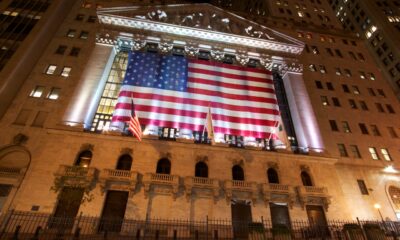Featured
6 financial market predictions for 2019
The market was highly volatile in 2018. Here are some predictions on how the financial market would fare this year.

Bond yields continue to fall in the first half of the year
The epoch bond bubble continues to build and become a dagger over the worldwide economy and markets. Wall Street Shills are fond of claiming that global bond yields remain at historically low levels due to central bank manipulations, but this argument is no longer tenable. It was once true, but QE on a net global basis has now gone negative. And data shows the amount of U.S. publicly traded debt relative to GDP is much greater today than it was prior to the start of the Great Recession—even after adjusted for the size of the Fed’s balance sheet—in other words, taking into account all the debt the Fed has purchased and is still rolling over.
The amount of publicly traded debt in the U.S. has soared to 58 percent of GDP. This is up from 29 percent in 2007 when the U.S. 10-year Note was yielding 5 percent. The Fed is now selling $50b of bonds each month, with an extra $7.8T in publicly traded debt that it doesn’t own; and that equates to nearly twice the amount of debt compared to GDP than what existed just prior to the Great Recession. This debt must now be absorbed by the private market and at a fair market price, instead of just purchased mindlessly by the Fed…and yet yields are still falling. This means investors are piling into sovereign debt for safety ahead of the global economic crisis even though they understand that debt is, for the most part, insolvent.
Recession begins prior to year’s end
The yield curve continues to invert and presages a recession that begins in late 2019. Meanwhile, the nucleus of the next credit crisis (the leveraged loan and junk bond markets) implode; as corporations need to roll over more than $800 billion of debt at much higher interest rates this year.
My Inflation/Deflation and Economic Cycle Model has 20 components. 19 out of 20 indicators are indicating we are about to enter into a recession. Only initial unemployment claims remain at a positive level. I believe GDP growth in Q1 2019 will have a one handle in front of it because the 2nd derivatives of growth and inflation are slowing significantly. Therefore, we are headed into sector 1 of my Inflation/Deflation and Growth Spectrum; where assets are falling sharply as the economy is deflating.
Trade war truce
The Main Stream Financial Media will continue to obsess over Trump’s twitter account to find out if some U.S. trade delegation met with someone in China and had a nice conversation. And, if President Trump announces that General Tso’s chicken is his favorite meal.
Trump will end the trade war soon and claim that it was the biggest and greatest deal in human history. Hence, my prediction: the tariffs against China are lifted in Q1 2019. This is what all the perma-bulls are waiting for. But that isn’t going to bail out the market. A trade deal with Mexico was reached back on August 27th, but that didn’t stop its stock market from crashing 20 percent. And it won’t help the U.S. market for very long either.
Debt and deficits soar globally
Sovereign debt skyrockets at an even faster pace than the breakneck speed witnessed since the Great Recession. In this same vein, in the U.S. the federal budget deficit surged to a record for the month of November to reach a negative $204.9 billion. The Treasury Department says that the deficit for November was $66.4 billion higher than November of 2017. For the first 2 months of this fiscal year, the deficit totaled $305.4 billion, up 51.4 percent from the same period last year. Deficits this high outside of a recession are both highly unusual and dangerous.
My prediction: the U.S. deficit for fiscal 2019 breaches far above $1 trillion; and this type of fiscal profligacy is replete throughout Asia, Europe and in emerging markets. Indeed, there isn’t a shred of prudence found pretty much anywhere in the world.
This massive increase of $70 trillion in debt since 2007, which adds up to $250 trillion globally, must now rely on the support of investors instead of the mindless and price insensitive purchases of central banks. Therefore, the potential for a 2012 European-style debt crisis occurring on a global basis is likely in 2019.
Equity markets go into free fall
The U.S. stock market takes its most significant leg down since 2008 in the first half of the year. The economic data and earnings reports will be extremely negative in comparison to the first half of 2018. For instance, Q2 of last year reported GDP growth of 4.2 percent. However, it is very likely that Q1 of this year will have GDP growth of just around 1 percent and Q2 could come in negative.
The total value of the market could drop by 25 percent and still be at a valuation level that is equal to 100 percent of GDP. And that assumes GDP doesn’t drop. But at 100 percent of GDP the market would still be, historically speaking, about twice as overvalued as it was from 1974-1990. Hence, I predict the worst of the stock market is still very much in front of us. The Fed will continue its $50 billion per month of reverse QE—at least until the stock market drops another 20 percent from here. And, the ECB is now out of its massive €80 billion per month QE program. Therefore, despite the fact that the Fed goes on hold with further rate hikes, asset prices remain in peril—at least until the Fed is actually cutting interest rates and ends Quantitative Tightening.

2019 will be marked by a conflagration in the U.S. government. (Source)
D.C. chaos
And finally, 2019 will be marked by a conflagration in our government. The year will be marred by budget showdowns and shutdowns, debt ceiling brinksmanship and indictments from Special Prosecutor Robert Mueller. Those hoping for cooperation between Democrats and Republicans on things such as a massive debt-funding infrastructure spending package to save the economy will be greatly disappointed. The cacophony between Democrats and Trump adds to the dysfunction in D.C. and puts added pressure on the market.
Concluding prediction
The global bond bubble continues to slam into the reality of the end of central bank support. That is the salient issue concerning economies and markets worldwide. Household net worth (think real estate and equity portfolios) as a percent of GDP reached over 525 percent at the start of Q3 last year. According to Forbes, the average for that figure is 380 percent going back to 1951. The sad fact is that the “health” of the global economy (however uneven and biased against the lower and middle classes) has become completely reliant upon the perpetual state of these unprecedented asset bubbles. Therefore, as they implode they are taking the global economy down with it.
This process will only intensify throughout 20109. As former Fed Chair Alan Greenspan said recently, “run for cover”…he’s finally got it right.
—
DISCLAIMER: This article expresses my own ideas and opinions. Any information I have shared are from sources that I believe to be reliable and accurate. I did not receive any financial compensation for writing this post, nor do I own any shares in any company I’ve mentioned. I encourage any reader to do their own diligent research first before making any investment decisions.

-

 Africa2 weeks ago
Africa2 weeks agoAgadir Welcomes Nearly 570,000 Tourists by May 2025
-

 Cannabis1 week ago
Cannabis1 week agoRecord-Breaking Mary Jane Fair in Berlin Highlights Cannabis Boom Amid Political Uncertainty
-

 Impact Investing2 weeks ago
Impact Investing2 weeks agoGlobal Gender Gap Progress Slows Amid Persistent Inequality and Emerging Risks
-

 Biotech5 days ago
Biotech5 days agoVytrus Biotech Marks Historic 2024 with Sustainability Milestones and 35% Revenue Growth


























You must be logged in to post a comment Login